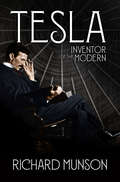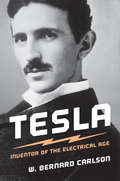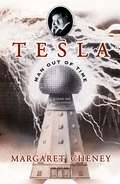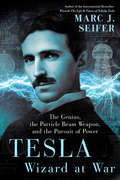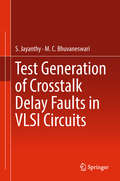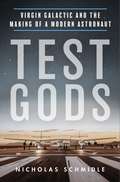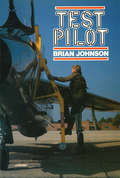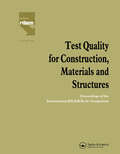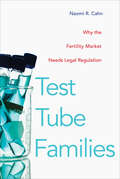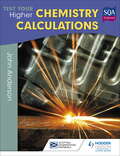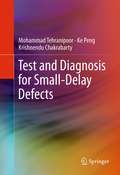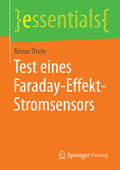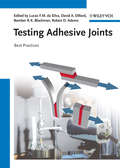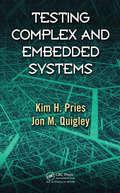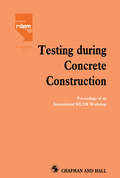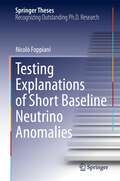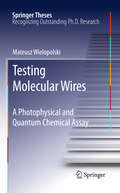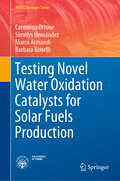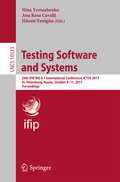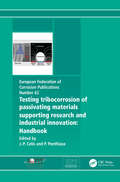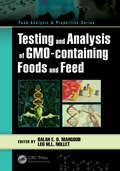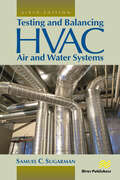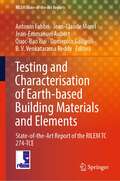- Table View
- List View
Tesla: Inventor Of The Modern
by Richard MunsonTesla’s inventions transformed our world, and his visions have continued to inspire great minds for generations. Nikola Tesla invented the radio, robots, and remote control. His electric induction motors run our appliances and factories, yet he has been largely overlooked by history. In Tesla, Richard Munson presents a comprehensive portrait of this farsighted and underappreciated mastermind. When his first breakthrough—alternating current, the basis of the electric grid—pitted him against Thomas Edison’s direct-current empire, Tesla’s superior technology prevailed. Unfortunately, he had little business sense and could not capitalize on this success. His most advanced ideas went unrecognized for decades: forty years in the case of the radio patent, longer still for his ideas on laser beam technology. Although penniless during his later years, he never stopped imagining. In the early 1900s, he designed plans for cell phones, the Internet, death-ray weapons, and interstellar communications. His ideas have lived on to shape the modern economy. Who was this genius? Drawing on letters, technical notebooks, and other primary sources, Munson pieces together the magnificently bizarre personal life and mental habits of the enigmatic inventor. Born during a lightning storm at midnight, Tesla died alone in a New York City hotel. He was an acute germaphobe who never shook hands and required nine napkins when he sat down to dinner. Strikingly handsome and impeccably dressed, he spoke eight languages and could recite entire books from memory. Yet Tesla’s most famous inventions were not the product of fastidiousness or linear thought but of a mind fueled by both the humanities and sciences: he conceived the induction motor while walking through a park and reciting Goethe’s Faust. Tesla worked tirelessly to offer electric power to the world, to introduce automatons that would reduce life’s drudgery, and to develop machines that might one day abolish war. His story is a reminder that technology can transcend the marketplace and that profit is not the only motivation for invention. This clear, authoritative, and highly readable biography takes account of all phases of Tesla’s remarkable life.
Tesla: Inventor of the Electrical Age
by W. Bernard CarlsonThe definitive account of Tesla's life and workNikola Tesla was a major contributor to the electrical revolution that transformed daily life at the turn of the twentieth century. His inventions, patents, and theoretical work formed the basis of modern AC electricity, and contributed to the development of radio and television. Like his competitor Thomas Edison, Tesla was one of America's first celebrity scientists, enjoying the company of New York high society and dazzling the likes of Mark Twain with his electrical demonstrations. An astute self-promoter and gifted showman, he cultivated a public image of the eccentric genius. Even at the end of his life when he was living in poverty, Tesla still attracted reporters to his annual birthday interview, regaling them with claims that he had invented a particle-beam weapon capable of bringing down enemy aircraft.Plenty of biographies glamorize Tesla and his eccentricities, but until now none has carefully examined what, how, and why he invented. In this groundbreaking book, W. Bernard Carlson demystifies the legendary inventor, placing him within the cultural and technological context of his time, and focusing on his inventions themselves as well as the creation and maintenance of his celebrity. Drawing on original documents from Tesla's private and public life, Carlson shows how he was an "idealist" inventor who sought the perfect experimental realization of a great idea or principle, and who skillfully sold his inventions to the public through mythmaking and illusion.This major biography sheds new light on Tesla's visionary approach to invention and the business strategies behind his most important technological breakthroughs.
Tesla: Man Out of Time
by Margaret CheneyIn this “informative and delightful” (American Scientist) biography, Margaret Cheney explores the brilliant and prescient mind of Nikola Tesla, one of the twentieth century’s greatest scientists and inventors.In Tesla: Man Out of Time, Margaret Cheney explores the brilliant and prescient mind of one of the twentieth century's greatest scientists and inventors. Called a madman by his enemies, a genius by others, and an enigma by nearly everyone, Nikola Tesla was, without a doubt, a trailblazing inventor who created astonishing, sometimes world-transforming devices that were virtually without theoretical precedent. Tesla not only discovered the rotating magnetic field -- the basis of most alternating-current machinery -- but also introduced us to the fundamentals of robotics, computers, and missile science. Almost supernaturally gifted, unfailingly flamboyant and neurotic, Tesla was troubled by an array of compulsions and phobias and was fond of extravagant, visionary experimentations. He was also a popular man-about-town, admired by men as diverse as Mark Twain and George Westinghouse, and adored by scores of society beauties. From Tesla's childhood in Yugoslavia to his death in New York in the 1940s, Cheney paints a compelling human portrait and chronicles a lifetime of discoveries that radically altered -- and continue to alter -- the world in which we live. Tesla: Man Out of Time is an in-depth look at the seminal accomplishments of a scientific wizard and a thoughtful examination of the obsessions and eccentricities of the man behind the science.
Tesla: The Genius, the Particle Beam Weapon, and the Pursuit of Power
by Marc SeiferIn this revelatory new book, the author of the award-winning international bestseller Wizard: The Life & Times of Nikola Tesla delves deeper into the groundbreaking ideas and astonishing mind of one of the greatest geniuses of modern times . . .&“In a few years hence, it will be possible for nations to fight without armies, ships or guns, by weapons far more terrible to the destructive action and range of which there is virtually no limit. Any city at any distance whatsoever from the enemy can be destroyed by him and no power on Earth can stop him from doing so.&” —Nikola Tesla, circa 1925 Drawing on forty years of research and a treasure trove of new information, Tesla: Wizard at War provides a comprehensive view of Tesla&’s discoveries, which continue to influence today&’s military technology and diplomatic strategies. One of the world&’s leading Tesla experts, Marc J. Seifer offers new insight into the brilliant scientist&’s particle beam weapon (aka the &“Death Ray&”) and explores his military negotiations with pivotal historical figures—including his links to Joseph Stalin, Vannevar Bush, General Andrew McNaughton, and Franklin Delano Roosevelt. From Tesla&’s role in the origins of Star Wars technology and his dynamic theory of gravity, to the real purpose behind the iconic tower at Wardenclyffe, this is an eye-opening account of Tesla&’s projects, passions, and ambitions—and an illuminating, important study of one of history&’s most intriguing figures.
Test Generation of Crosstalk Delay Faults in VLSI Circuits
by M. C. Bhuvaneswari S. JayanthyThis book describes a variety of test generation algorithms for testing crosstalk delay faults in VLSI circuits. It introduces readers to the various crosstalk effects and describes both deterministic and simulation-based methods for testing crosstalk delay faults. The book begins with a focus on currently available crosstalk delay models, test generation algorithms for delay faults and crosstalk delay faults, before moving on to deterministic algorithms and simulation-based algorithms used to test crosstalk delay faults. Given its depth of coverage, the book will be of interest to design engineers and researchers in the field of VLSI Testing.
Test Gods: Virgin Galactic and the Making of a Modern Astronaut
by Nicholas SchmidleIn the spirit of The Right Stuff, updated for the 21st century, Test Gods is an epic story about extreme bravery and sacrifice, about the thin line between lunacy and genius. Most of all, it is a story about the pursuit of meaning in our lives—and the fulfillment of our dreams.Working from exclusive inside reporting, New Yorker writer Nicholas Schmidle tells the remarkable story of the test pilots, engineers, and visionaries behind Virgin Galactic’s campaign to build a space tourism company. Schmidle follows a handful of characters—Mark Stucky, Virgin’s lead test pilot; Richard Branson, the eccentric billionaire funding the venture; Mike Moses, the grounded, unflappable president; Mike Alsbury, the test pilot killed in a fatal crash; and others—through personal and professional dramas, in pursuit of their collective goal: to make space tourism a reality.Along the way, Schmidle weaves his relationship with his father—a former fighter pilot and decorated war hero—into the tragedies and triumphs that Branson’s team confronts out in the Mojave desert as they design, build, and test-fly their private rocket ship. Gripping and novelistic, Test Gods leads us, through human drama, into a previously unseen world—and beyond.
Test Pilot
by Brian JohnsonTest pilots - dashing and courageous young men or foolhardy gamblers? In this fully illustrated book written by the producer of the BBC1 television series of the same name, we follow the ups and downs of a group of trainee test pilots at Boscombe Down in Wiltshire.Beginning with the exacting selection procedure, we discover what personal and professional qualities a pilot needs in order to become a test pilot. Only six UK and twelve foreign students are chosen each year and, once selected, the pressure on them steadily mounts. As the students learn to push each aircraft's performance to its limits they, too, are being mentally and physically stretched further than ever before. Training is given on both fixed - and rotary - wing aircraft and by the end of the course each student is fully conversant with the different techniques necessary to fly each type. They learn how to recover safely from spins, how to cope with sudden failures of equipment in mid-flight and how to land an aircraft with no power. All the time, they are assessing each aircraft's capabilities and the scope of the on-board technology. The final part of the course is the 'preview exercise' when every student is required to evaluate an aircraft he has never flown before and to make a formal presentation to his tutors and examiners.Using a number of remarkably frank interviews with students and tutors, Brian Johnson explores the process of becoming a test pilot and reveals both the stresses and successes of the year. The RAF has given its full support to both the book and the television programmes and thus has enabled Brian Johnson to produce a unique and authoritative account of the training for one of the most responsible and exciting jobs in modern aviation.
Test Quality for Construction, Materials and Structures: Proceedings of the International RILEM/ILAC Symposium
by M. FickelsonTesting of materials and manufactured items is a key element in the process from standard specifications though control and verification during manufacture to trade in actual products. Cooperative agreements and networks are being set up covering reference materials and calibration. This process is becoming more urgent with the development in the E
Test Tube Families: Why the Fertility Market Needs Legal Regulation
by Naomi R CahnThe birth of the first test tube baby in 1978 focused attention on the sweeping advances in assisted reproductive technology (ART), which is now a multi-billion-dollar business in the United States. Sperm and eggs are bought and sold in a market that has few barriers to its skyrocketing growth. While ART has been an invaluable gift to thousands of people, creating new families, the use of someone else’s genetic material raises complex legal and public policy issues that touch on technological anxiety, eugenics, reproductive autonomy, identity, and family structure. How should the use of gametic material be regulated? Should recipients be able to choose the “best” sperm and eggs? Should a child ever be able to discover the identity of her gamete donor? Who can claim parental rights?Naomi R. Cahn explores these issues and many more in Test Tube Families, noting that although such questions are fundamental to the new reproductive technologies, there are few definitive answers currently provided by the law, ethics, or cultural norms. As a new generation of "donor kids" comes of age, Cahn calls for better regulation of ART, exhorting legal and policy-making communities to cease applying piecemeal laws and instead create legislation that sustains the fertility industry while simultaneously protecting the interests of donors, recipients, and the children that result from successful transfers.
Test Your Higher Chemistry Calculations 3rd Edition
by John AndersonIdeal practice material for an element of Higher Chemistry that contributes to over 20% of the final exam grade.Calculations are one of the most challenging areas for Higher Chemistry candidates, and this edition of Test Your Higher Cemistry Calculations is brought completely up to date for the newest CfE revisions of the exam.- Extensive overview of all types of questions likely to be tested- Exploration of theory behind each topic in each chapter- Worked examples and problems throughout
Test Your Higher Chemistry Calculations 3rd Edition
by John AndersonExam Board: SQALevel: HigherSubject: ChemistryFirst Teaching: September 2014First Exam: Summer 2015Ideal practice material for one of the most challenging areas for Higher Chemistry candidates.This edition of Test Your Higher Chemistry Calculations provides:> Extensive overview of all types of questions likely to be tested> Exploration of the theory behind each topic in each chapter> Worked examples and problems
Test and Diagnosis for Small-Delay Defects
by Mohammad Tehranipoor Krishnendu Chakrabarty Ke PengThis book will introduce new techniques for detecting and diagnosing small-delay defects in integrated circuits. Although this sort of timing defect is commonly found in integrated circuits manufactured with nanometer technology, this will be the first book to introduce effective and scalable methodologies for screening and diagnosing small-delay defects, including important parameters such as process variations, crosstalk, and power supply noise.
Test eines Faraday-Effekt-Stromsensors (essentials)
by Reiner ThieleReiner Thiele führt in die polarisationsoptischen Grundlagen der Sensortechnik ein. Er zeigt dazu, ausgehend von einer Faraday-Effekt-Applikation zur Messung hoher elektrischer Ströme, das Verfahren zum Test optischer und elektronischer Sensorkomponenten auf. Seine Testergebnisse erlauben die Erkennung von Schwachstellen im Sensor und führen auf Möglichkeiten zu deren Kompensation. Daraus resultieren effiziente Methoden zur Elimination der störenden Doppelbrechung in optischen Kopplern.
Testing Active and Passive Electronic Components
by Richard.F. PowellThis book meets the vital need of providing one place where a comprehensive information on how to test more than one type of electronic component. The monograph gathers together data from scattered literature, including books, manufacturers' guides, instruction manuals, application notes and military and industry standards and provides a key information necessary to allow users to get started immediately on component testing and presents effective options for handling high-, low- and medium-volume testing.
Testing Adhesive Joints
by Robert D. Adams David A. Dillard Bamber Blackman Lucas F.M. da SilvaJoining techniques such as welding, brazing, riveting and screwing are used by industry all over the world on a daily basis. A furthermethod of joining has also proven to be highly successful: adhesive bonding. Adhesive bonding technology has an extremely broad rangeof applications. And it is difficult to imagine a product - in the home, in industry, in transportation, or anywhere else for that matter - thatdoes not use adhesives or sealants in some manner. The book focuses on the methodology used for fabricating and testing adhesive and bonded joint specimens. The text covers a wide range of test methods that are used in the field of adhesives, providing vital information for dealing with the range of adhesive properties that are of interest to the adhesive community. With contributions from many experts in the field, the entire breadth of industrial laboratory examples, utilizing different best practice techniques are discussed. The core concept of the book is to provide essential information vital for producing and characterizing adhesives and adhesively bonded joints.
Testing Complex and Embedded Systems
by Jon M. Quigley Kim H. PriesMany enterprises regard system-level testing as the final piece of the development effort, rather than as a tool that should be integrated throughout the development process. As a consequence, test teams often execute critical test plans just before product launch, resulting in much of the corrective work being performed in a rush and at the last minute. Presenting combinatorial approaches for improving test coverage, Testing Complex and Embedded Systems details techniques to help you streamline testing and identify problems before they occur—including turbocharged testing using Six Sigma and exploratory testing methods. Rather than present the continuum of testing for particular products or design attributes, the text focuses on boundary conditions. Examining systems and software testing, it explains how to use simulation and emulation to complement testing. Details how to manage multiple test hardware and software deliveries Examines the contradictory perspectives of testing—including ordered/ random, structured /unstructured, bench/field, and repeatable/non repeatable Covers essential planning activities prior to testing, how to scope the work, and how to reach a successful conclusion Explains how to determine when testing is complete Where you find organizations that are successful at product development, you are likely to find groups that practice disciplined, strategic, and thorough testing. Tapping into the authors’ decades of experience managing test groups in the automotive industry, this book provides the understanding to help ensure your organization joins the likes of these groups.
Testing During Concrete Construction: Proceedings of RILEM Colloquium, Darmstadt, March 1990
by H. W. ReinhardtTesting concrete while construction is underway enables decisions to be made which can improve the quality of the finished structure. The book covers testing and measuring techniques for fresh concrete and concrete during the first few days after placing, and for reinforcement and prestressing tendons. Many examples are given of practical methods w
Testing Explanations of Short Baseline Neutrino Anomalies (Springer Theses)
by Nicolò FoppianiThis thesis, encompassing both theory to experiment, guides the reader in a pedagogical way through the author’s attempts to resolve the mystery of the so-called MiniBooNE anomaly, where unexpected neutrino oscillations were reported, potentially explainable by the existence of light sterile neutrinos, but in contradiction with several null results. Within this context, this thesis reports one of the first analyses searching for an excess of electrons in the MicroBooNE experiment finding no excess of events and narrowing down the possible explanations for the anomaly. Additionally, this thesis explores non-minimal heavy neutral leptons as potential explanations for the MiniBooNE excess. To search for evidence for this particle, the author performs an analysis using data from the T2K experiment, which searched for pairs of electrons using a gas argon time projection. This thesis provides a comprehensive explanation of the MiniBooNE anomaly and test of its possibile explanation with liquid and gas time projection chambers.
Testing Molecular Wires
by Mateusz WielopolskiThe field of molecular electronics and organic photovoltaics is steadily growing. One of the major themes in molecular electronics is the construction, measurement, and understanding of the current-voltage response of an electronic circuit, in which molecules may act as conducting elements. The investigated molecular structures in this thesis have been shown to be suitable for distance-independent charge transport. More precisely, the systems investigated were of particular interest due to their ability to provide efficient electronic coupling between electroactive units, and display wire-like behavior in terms of transferring charges from donors to acceptors. Besides impacting on the field of molecular electronics, the results of this research also has applications in the design and development of light harvesting, photoconversion and catalytic modules. This work is a great asset to the field of charge transport through organic pi-conjugated molecules.
Testing Novel Water Oxidation Catalysts for Solar Fuels Production (PoliTO Springer Series)
by Carminna Ottone Simelys Hernández Marco Armandi Barbara BonelliThis book offers comprehensive information on the main techniques for measuring water-oxidation-catalyst (WOC) performance, with a particular focus on the combined use of sacrificial oxidants and dyes within closed-batch reactors. It provides an overview of the latest advances in the synthesis of more efficient WOCs, followed by an analysis of the requirements for sustainable energy production. Readers will find a detailed description of the reaction mechanism used in catalyst assessment systems, which reveals the benefits and limitations of the most common sacrificial oxidant/dye pair. Experimental techniques including electrochemical methods for characterizing novel and non-photoactive WOCs are also described. Throughout the book, various manganese oxides are used as examples of the techniques reviewed or proposed systems. Cost considerations and technological perspectives of the scale-up of solar-driven hydrogen production are also addressed. Lastly, the book presents lessons learned from the implementation of a large-scale real-world device.
Testing Software and Systems
by Nina Yevtushenko Ana Rosa Cavalli Hüsnü YenigünThis book constitutes the refereed proceedings of the 29th IFIP WG 6. 1 International Conference on Testing Software and Systems ICTSS 2017, held in St. Petersburg, Russia, in October 2017. The 18 full papers and 4 short papers presented were carefully reviewed and selected from 41 submissions. The topics of the volume cover model based testing; test derivation and monitoring; fault localization and system testing including real time systems.
Testing Tribocorrosion of Passivating Materials Supporting Research and Industrial Innovation: A Handbook (European Federation Of Corrosion Publications #62)
by Jean-Pierre CelisThis first edition of Testing Tribocorrosion of Passivating Materials Supporting Research and Industrial Innovation: A Handbook treats in a clear, concise, and practical manner an important material degradation and protection matter. It is designed as a handbook and provides a well structured approach of the basics needed to investigate the tribocorrosion behavior of passivating materials, and to conduct in a correct way a laboratory investigation on it. It provides answers on practical and theoretical approaches of tribocorrosion phenomena to engineers and medical persons involved with material assemblies subjected to aggressive environmental and mechanical conditions. For academic researchers it is a pertinent tool assisting them in how they can perform a tribocorrosion investigation and obtain results that are correctly interpreted and can be exchanged. Different parts of the book are illustrated with practical examples. This handbook is truly an indispensable guide for every professional who comes into contact with the complex material degradation and protection processes that take place under combined corrosion and wear conditions. Fields of interest include: transportation (aeronautics, maritime, rail, automotive), medical implants (orthopaedics, dentistry), biochemistry, food production, energy production, and machining. The coordination of this handbook writing was done by Professor Jean-Pierre Celis (Katholieke Universiteit Leuven, Belgium) and Professor Pierre Ponthiaux (Ecole Centrale Paris, France) assisted by twelve European experts who contributed jointly to the nine chapters of this handbook. Main topics dealt with are tribocorrosion phenomena in medical and industrial sectors, depassivation and repassivation phenomena, impact on synergism in tribocorrosion, specific testing techniques, coupling tribology-to-corrosion, design of a testing protocol, and normalisation.
Testing and Analysis of GMO-containing Foods and Feed (Food Analysis & Properties)
by Leo M. L. Nollet Salah E. O. MahgoubAn increasing number of genetically modified organisms (GMOs) continues to be produced every day. In response to the concerns raised by the development of GMOs and their incorporation in foods and feed, guidelines and regulations to govern and control the use of GMOs and their products have been enacted. These regulations necessitated the design of methods to detect and analyse the presence of GMOs or their products in agriculture produce, food and feed production chains. Design of techniques and instruments that would detect, identify, and quantify GM ingredients in food and feed will help inspection authorities to relay reliable information to consumers who might be concerned about the presence of GM ingredients. Information generated by detection of GMOs in food and feed would be helpful for setting regulations that govern the use of GM components as well as for labeling purposes. Qualitative detection methods of GM-DNA sequences in foods and feeds have evolved fast during the past few years. There is continuous need for the development of more advanced multi-detection systems and for periodic updates of the databases related to these systems. Testing and Analysis of GMO-containing Foods and Feed presents updates and comprehensive views on the various methods and techniques in use today for the detection, identification and quantification of GMOs in foods and feed. The eleven book chapters cover recent developments on sample preparation techniques, immunoassays methods and the PCR technique used in GMO analysis, the use of biosensors in relation to GMO analysis, the application of nucleic acid microarrays for the detection of GMOs, validation and standardization methods for GMO testing, in addition to the type of reference material and reference methods used in GMO testing and analysis. Some of the ISO standards designed for identifying and detecting the presence of GM material in foods are also presented in the book.
Testing and Balancing HVAC Air and Water Systems
by Samuel C. SugarmanThis thoroughly revised book will provide the reader with an understanding of the principles and practices of testing and balancing (TAB) heating, ventilating and air conditioning (HVAC) air and water systems. It is for anyone interested in testing and balancing. For the novice and the experienced testing and balancing technician, it is a field reference book of procedures, equations, and information tables. For those interested in getting into TAB or who are new to the HVAC industry, it is a text for learning more about HVAC systems and testing and balancing. For the mechanical engineer, building owner, facility manager, commissioning agency or energy manager, this book can be used for teaching TAB, writing more effective specifications, and learning about TAB and how it interacts with system commissioning, indoor air quality and energy management. It is the intent of this book to improve the communications between owners, mechanical engineers, designers, vendors, contractors, TAB engineers, supervisors, and technicians to ensure that HVAC systems are being thoroughly tested and balanced. This book is used in test and balance self-study courses, in-house training programs, seminars, and other training formats as preparation for TAB certification, and as a text in colleges and technical schools. The sixth edition has general and specific testing and balancing procedures for constant air volume systems, variable air volume systems, return air and exhaust air systems, positive and negative pressure conditioned spaces, and fans and fan performance in Chapters 1 through 9. Chapters 10–12 cover testing and balancing fume hood systems, and cleanrooms and commissioning HVAC systems. Chapters 13 and 14 provide information on water systems and centrifugal pumps including water balancing procedures using flow meters, system components and temperatures, and water pumps and pump performance. Chapter 15 reviews analog and digital controls. Chapters 16–20 cover terminology for fluid flow, psychrometrics, refrigeration¸ air distribution, water distribution, fans and pumps, motors, electrical, and instrument usage and care. Chapters 21 and 22 are equations and tables.
Testing and Characterisation of Earth-based Building Materials and Elements: State-of-the-Art Report of the RILEM TC 274-TCE (RILEM State-of-the-Art Reports #35)
by Jean-Claude Morel B. V. Venkatarama Reddy Antonin Fabbri Jean-Emmanuel Aubert Quoc-Bao Bui Domenico GallipoliThis book presents the work done by the RILEM Technical Committee 274-TCE. It focuses on the estimation of the parameters which are necessary to properly design earthen constructions. It provides a compilation of the value classically obtained for the key parameters of earthen materials, a pedagogical presentation of the main testing procedures for earthen materials, their advantage and their drawback and an overview of most standards on earthen materials, whatever their origin and their language.The book is divided into eight chapters. After a general introduction on earthen materials and constructions, the state of the art on the material characterisation technics, the assessment of hygrothermal performance, the mechanical behaviour, seismic resistance and the durability will be presented, each in a dedicated chapter. On the basis of these last chapters, a critical review of the standards which are used for earthen material will be presented in the last chapter. The last chapter is dedicated to the analysis of the environmental potential of earth-based building materials.
